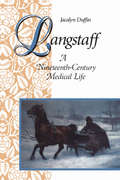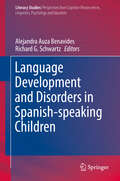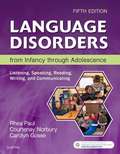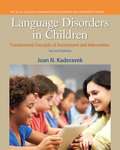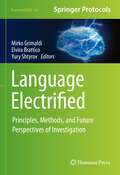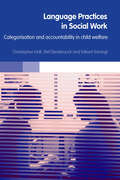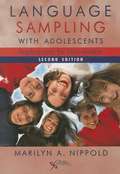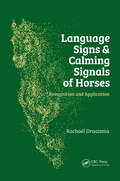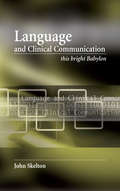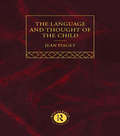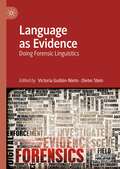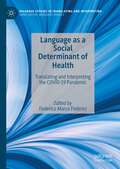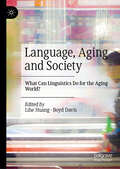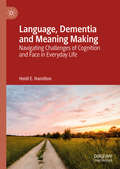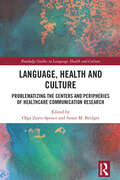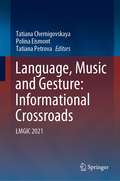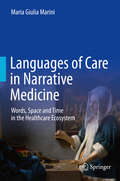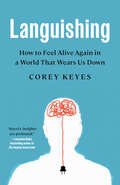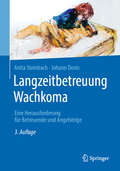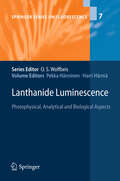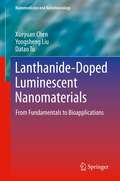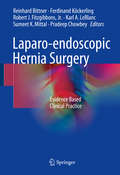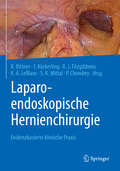- Table View
- List View
Langstaff: A Nineteenth-Century Medical Life
by Jacalyn DuffinA unique and readable microhistory of an ordinary physician and his community during a period of revolutionary medical change. Duffin bases her insights on a detailed computer-assisted analysis of 40 years of extant daybooks of James Langstaff (1825-1889).
Language Development and Disorders in Spanish-speaking Children
by Richard G. Schwartz Alejandra Auza BenavidesProminent researchers from the US, Mexico, Chile, Colombia and Spain contribute experimental reports on language development of children who are acquiring Spanish. The chapters cover a wide range of dimensions in acquisition: comprehension and production; monolingualism and bilingualism; typical development, children who are at risk and children with language disorders, phonology, semantics, and morphosyntax. These studies will inform linguistic theory development in clinical linguistics as well as offer insights on how language works in relation to cognitive functions that are associated with when children understand or use language. The unique data from child language offer perspectives that cannot be drawn from adult language. The first part is dedicated to the acquisition of Spanish as a first or second language by typically-developing children, the second part offers studies on children who are at risk of language delays, and the third part focuses on children with specific language impairment, disorders and syndromes.
Language Disorders from Infancy through Adolescence: Listening, Speaking, Reading, Writing, and Communicating
by Rhea Paul Courtenay Norbury Carolyn GosseSpanning the entire childhood developmental period, Language Disorders from Infancy Through Adolescence, 5th Edition is the go-to text for learning how to properly assess childhood language disorders and provide appropriate treatment. The most comprehensive title available on childhood language disorders, it uses a descriptive-developmental approach to present basic concepts and vocabulary, an overview of key issues and controversies, the scope of communicative difficulties that make up child language disorders, and information on how language pathologists approach the assessment and intervention processes. This new edition also features significant updates in research, trends, social skills assessment, and instruction best practices.
Language Disorders in Children: Fundamental Concepts of Assessment and Intervention
by Joan N. KaderavekThis text is more than an introductory look at language disorders. It goes beyond basic concepts and basic definitions to teach students how to analyze, synthesize, evaluate, and link the information they are learning. It offers readers opportunities for higher-order learning, while preparing students to become careful evaluators of information, as well as adept problem solvers. Organized by disorder groups and theme, Language Disorders in Children, 2/e helps students easily make connections between theoretical information and clinical practice through a number of thoughtful features such as case histories, clinical decision trees, and hot topic discussions. It's an approach that meets the needs of today's students to learn lifetime critical thinking skills, to see relationships between isolated ideas and facts, and to think like a speech-language pathologist.
Language Electrified: Principles, Methods, and Future Perspectives of Investigation (Neuromethods #202)
by Elvira Brattico Mirko Grimaldi Yury ShtyrovLanguage, as a system we use to communicate, represents the brain’s biologically perfected machinery for converting thoughts (ideas, concepts, and reflections of both the outside world and our inner feelings) into words and sentences. Crucially, this process occurs in real time. How hundreds of billions of neurons within the dark of the skull control language and speech remains, in some respects, a mystery. To track such neural dynamics in time, we need to exploit physiological tools capable of following temporal patterns of neural activity on a fine-grain time scale. In parallel, it is necessary to begin to provide a real interdisciplinary academic background for scholars wishing to embark on this field of study. Unlike many similar efforts, this book has been conceived as a hands-on tool offering the reader the possibility to progressively acquire principles, techniques, and methods necessary to pursue interdisciplinary research in a fascinating field intersecting linguistic and neuroscience. It focuses on neurophysiological methods and applications useful to track the high speed and rapid temporal dynamics of neural activity involved in language and speech. The chapters in this book are organized into four parts. Part One discusses neural principles and tools for an effective approach to the field of investigation. Part Two looks at the issues and perspectives concerned with the use of a range of neurophysiological technologies to investigate the neural computations of language and speech processes. Part Three focuses on an in-depth exploration of the neural processes associated with the main types of linguistic information, ranging from phonemes and prosody to syntax, pragmatics, and figurative language. Lastly, Part Five explores the phenomena that goes beyond the segments of basic linguistic units. In the Neuromethods series style, chapters include the kind of detail and key advice from the specialists needed to get successful results in your laboratory Cutting-edge and thorough, Language Electrified: Principles, Methods, and Future Perspectives of Investigation is a valuable resource that offers the necessary tool-box for all researchers and scientists interested in the challenging field of the neurophysiology of language and speech.
Language Learning in Children Who Are Deaf and Hard of Hearing: Multiple Pathways
by Susan R. Easterbrooks Sharon BakerThis book addresses the language development process from multiple perspectives, drawing on the latest research in bilingual biculturalism, cochlear implant technology and neuroscience. The book presents a unique view of language development, proposing that there are multiple pathways to the acquisition of a system of communication. For parents and educators working with deaf and hard of hearing children.
Language Practices in Social Work: Categorisation and Accountability in Child Welfare
by Srikant Sarangi Christopher Hall Stefaan SlembrouckAnalysis of language and discourse in social sciences has become increasingly popular over the past thirty years. Only very recently has it been applied to the study of social work, despite the fact that communication and language are central to social work practice. This book looks at how social workers, their clients and other professionals categorise and manage the problems of social work in ways which are rendered understandable, accountable and which justify professional intervention. Features include: studies of key practice areas in social work, such as interviews, case conferences, home visits analysis of the language and construction used in typical case studies of everyday social work practice exploration of the ways in which professionals can examine their own practice and uncover the discursive, narrative and rhetorical methods that they use. The purpose of this engaging study is to increase awareness of language and discourse in order to help develop better practice in social work. It is essential reading for professionals in social work, child welfare and the human services and will be a valuable contribution to the study of professional language and communication.
Language Sampling with Adolescents: Implications for Intervention (Second Edition)
by Marilyn A. Nippold<p>Language Sampling with Adolescents: Implications for Intervention, now in its second edition, provides guidelines for analyzing spoken and written language production in adolescents. It is geared toward graduate students and speech-language pathologists who work in the public schools with middle school and high school students (Grades 5-12). The book includes many tables, figures, and practical exercises (with answer keys) to help readers understand how to analyze the content and structure of what adolescents express in different genres: conversational, narrative, expository, and persuasive. Based on formal analyses, the book indicates how the information can be applied to establish functional language goals for adolescents with language disorders. It also explains how to implement intervention activities that are designed to enhance spoken and written language production in adolescents. <p>For the second edition, the author has revised and updated the content and added a new chapter on "Adolescent Language Disorders" that includes information on specific language impairment, nonspecific language impairment, and autism spectrum disorder. </p>
Language Signs and Calming Signals of Horses: Recognition and Application
by Rachaël DraaismaThis practical book helps you interpret and connect the physical signals that horses display in response to their environment. These signals are evident in the everyday actions, gestures and attitudes that horses communicate to each other, but are often so subtle that they can go unnoticed by humans. This book aims to rectify that, offering horse lovers and equine professionals an opportunity to gain a unique insight into their 'horse's world'.Key features:includes detailed description of language signs of domestic horses, with a special emphasis on calming signalsincludes 275 pictures to visualize various language signs, calming signals, behaviour sequences and facial featurespresents communication ladders to show how a horse responds to incentives in his environment, and what signals he uses at certain momentscontains tips on the use of the communication ladders and calming signals to improve the socialisation, training and wellbeing of your horseconsiders equine psychological stress from an environmental perspective, providing a valuable alternative to the current common clinical perspective.After reading this book you will be more astute in spotting calming signals, displacement activities, stress signals and distance-increasing signals, and better able to see which stimuli your horse can handle and which he cannot. This means you will know what to do to calm your horse before his stress rises to an unmanageable level. Language Signs and Calming Signals of Horses is both fascinating and important reading for any equine veterinary practitioner, student or nurse, as well as horse owners and trainers.
Language and Clinical Communication: This Bright Babylon
by John Skelton Dominic GreenyerThe search for a set of skills which can be identified and taught as 'good clinical communication' has been of considerable value in persuading decision makers at medical schools and other bodies that communication matters. These days, very large numbers of medical schools use what are essentially skills-based models, such as the extraordinarily thorough Calgary-Cambridge approach. However, I believe that the emphasis on communication' as simply a set of skills, such as eye contact, open questions and so on, has badly skewed the development of the discipline. The teaching of "communication skills" in fact strikes me as a very small part of what I do, not a very difficult part for the majority of students, and - whisper it - one which is often pretty dull...In "Language and Clinical Communication", John Skelton critically considers the theory behind this complex field. His wide-ranging approach reflects on the recent developments within the medical humanities and reflects on his controversial stance; questioning the relevance of skill-based teaching in the clinical arena in an accessible, easy to read manner. You will find Skelton's light-hearted and open-minded attitude to the topic unquestionably illuminating.
Language and Thought of the Child: Selected Works vol 5 (Routledge Classics Ser.)
by Jean PiagetJean Piaget was one of the most salient and inspirational figures in psychological and educational research of the 20th century. He was also prolific, authoring or editing over 80 books and numerous journals and papers which spawned a continuation of his work over the following decades. His work now compromises a major component of many courses on children's psychological development and in a research tradition which is expanding, scholars may need access to the original texts rather than secondhand accounts. This volume is the sixth of nine reproducing Piaget's original works - they are also available as a boxed set.
Language as Evidence: Doing Forensic Linguistics
by Dieter Stein Victoria Guillén-NietoThis edited book provides a comprehensive survey of the modern state of the art in forensic linguistics. Part I of the book focuses on the role of the linguist as an expert witness in common law and civil law jurisdictions, the relation of expert witnesses and lawyers, ethics standards, and courtroom interaction. Part II deals with some of the major areas of expertise of forensic linguistics as the scientific study of language as evidence, namely authorship identification, speaker identification, text authentication, deception and lie detection, plagiarism detection, and cyber language crimes. This book is intended to be used as a reference for academics, students and practitioners of Linguistics, Forensic Linguistics, Law, Criminology, and Forensic Psychology, among other disciplines.
Language as a Social Determinant of Health: Translating and Interpreting the COVID-19 Pandemic (Palgrave Studies in Translating and Interpreting)
by Federico Marco FedericiThis edited volume demonstrates the fundamental role translation and interpreting play in multilingual crises. During the COVID-19 pandemic, limited language proficiency of the main language(s) in which information is disseminated exposed people to additional risks, and the contributors analyse risk communication plans and strategies used throughout the world to communicate measures through translation and interpreting. They show that a political willingness to understand the role of language in public health could lead local and national measures to success, sampling approaches from across four continents. The book will be of interest to students and scholars of healthcare translation and interpreting, sociolinguistics and crisis communication, as well as practitioners of risk and crisis communication and professional translators and interpreters.
Language, Aging and Society: What Can Linguistics Do for the Aging World?
by Lihe Huang Boyd DavisThis book explores how studies of language and aging can be applied to build an aging-friendly society, drawing on the socio-pragmatic turn in language and aging to examine the perspectives of older adults experiencing aging through a linguistic lens. Research on the phenomenon and mechanisms of language in aging can provide older adults with language training, increase their active aging, and offer improved information communication channels for an aging society, which will bring a series of clinical and social benefits to handle problems in aging and language across the world. This book will be of interest to researchers in linguistics, sociology, gerontology and related fields.
Language, Dementia and Meaning Making: Navigating Challenges of Cognition and Face in Everyday Life
by Heidi E. HamiltonThis book investigates the ways in which context shapes how cognitive challenges and strengths are navigated and how these actions impact the self-esteem of individuals with dementia and their conversational partners. The author examines both the language used and face maintenance in everyday social interaction through the lens of epistemic discourse analysis. In doing so, this work reveals how changes in cognition may impact the faces of these individuals, leading some to feel ashamed, anxious, or angry, others to feel patronized, infantilized, or overly dependent, and still others to feel threatened in both ways. It further examines how discursive choices made by healthy interactional partners can minimize or exacerbate these feelings. This path-breaking work will provide important insights for students and scholars of sociolinguistics, applied linguistics, medical anthropology, and health communication.
Language, Health and Culture: Problematizing the Centers and Peripheries of Healthcare Communication Research (Routledge Studies in Language, Health and Culture)
by Susan M. Bridges Olga Zayts-SpenceLanguage, Health and Culture brings together contributions by linguistic scholars working in the area of health communication in Asia—in particular, in Hong Kong, Mainland China, Singapore, Japan and Taiwan. Olga Zayts-Spence and Susan M. Bridges, along with the contributors, draw on a diverse range of authentic data from different (primary, secondary, digital) healthcare contexts across Asia. The contributions probe empirical analyses and meta-reflections on the empirical, epistemological and theoretical foundations of doing research on language and health communication in Asia. While many of the medical and technological advances originate from the ‘non-English-dominant’/‘peripheral’ contexts, when it comes to health communication, there is a strong tendency to downplay and marginalize the scope and the impact of the ripe research tradition in these contexts. The contributions to the edited volume problematize the hegemony of dominant (Anglocentric) traditions in health communication research by highlighting culture- and context-specific ways of interpreting different health realities through linguistic lenses.
Language, Music and Gesture: LMGIC 2021
by Polina Eismont Tatiana Chernigovskaya Tatiana PetrovaThis book brings together selected revised papers representing a multidisciplinary approach to language, music, and gesture, as well as their interaction. Among the number of multidisciplinary and comparative studies of the structure and organization of language and music, the presented book broadens the scope with the inclusion of gesture problems in the analyzed spectrum. A unique feature of the presented collection is that the papers, compiled in one volume, allow readers to see similarities and differences in gesture as an element of non-verbal communication and gesture as the main element of dance. In addition to enhancing the analysis, the data on the perception and comprehension of speech, music, and dance in regard to both their functioning in a natural situation and their reflection in various forms of performing arts makes this collection extremely useful for those who are interested in human cognitive abilities and performing skills. The book begins with a philosophical overview of recent neurophysiological studies reflecting the complexity of higher cognitive functions, which references the idea of the baroque style in art being neither linear nor stable. The following papers are allocated into 5 sections. The papers of the section “Language-Music-Gesture As Semiotic Systems” discuss the issues of symbolic and semiotic aspects of language, music, and gesture, including from the perspective of their notation. This is followed by the issues of "Language-Music-Gesture Onstage" and interaction within the idea of the "World as a Text." The papers of “Teaching Language and Music” present new teaching methods that take into account the interaction of all the cognitive systems examined. The papers of the last two sections focus on issues related primarily to language: The section "Verbalization Of Music And Gesture" considers the problem of describing musical text and non-verbal behavior with language, and papers in the final section "Emotions In Linguistics And Ai-Communication Systems” analyze the ways of expressing emotions in speech and the problems of organizing emotional communication with computer agents.
Languages of Care in Narrative Medicine: Words, Space and Time in the Healthcare Ecosystem
by Maria Giulia MariniThis book explains how narrative medicine can improve evidence based medicine (EBM), making it more effective and efficient, giving patients better quality of life and offering more satisfaction to all health care providers. It discusses not only the disease experienced by the person who is ill, but also focuses on the context and the culture, and investigates how narrative medicine can make other disciplines around the globe more applicable, less manipulative, and more “scientific”. Only by integrating the narrative aspects, can EBM become more effective and efficient, with fewer uncured patients, more satisfied patients with a better quality of life, and satisfaction for all health care providers. Every chapter is divided into two main sections: the first presents the latest research in the field, with comments and interviews with experts, while the second section provides a list of practical exercises and tasks. The book is intended for anyone with an interest in caring for and curing patients: all care providers of care, physicians, general practitioners, specialists nurses, psychotherapists, counselors, social workers, providers of aid, healthcare managers, scientific societies, academics and researchers.
Languishing: How to Feel Alive Again in a World That Wears Us Down
by Corey Keyes&“With his pioneering research, Corey Keyes put languishing on the map. In this powerful book, he brings it to life. Get ready to rethink your understanding of mental health, update your views on happiness, and come closer to realizing your potential.&”—Adam Grant, #1 New York Times bestselling author of Hidden PotentialIf you&’re muddling through the day in a fog, often forgetting why you walked into a room . . . If you feel emotionally flattened, lacking the energy to socialize or feel joy in the small things . . . If you feel an inner void—like something is missing, but you aren&’t sure what . . . Then this book is for you.Languishing—the state of mental weariness that erodes our self-esteem, motivation, and sense of meaning—can be easy to brush off as the new normal, especially since indifference is one of its symptoms. It is not a synonym for depression and its attendant state of prolonged sadness. Languishers are more likely to feel out of control of their lives, uncertain about what they want from the future, and paralyzed when faced with decisions. Left unchecked, languishing not only impedes our daily functioning but is a gateway to serious mental illness and early mortality.Emory University sociologist Corey Keyes has spent his career studying the causes and costs of languishing—the neglected middle child of mental health. Now Keyes has written the first definitive book on the subject, examining the ripple effect of languishing on our lives before deftly diagnosing the larger forces behind its rise: the false promises of the self-help industrial complex, a global moment of intense fear and loss, and a failing healthcare system focused on treating rather than preventing illness.Ultimately, Keyes presents a counterintuitive approach to breaking the cycles keeping us stuck and finding a path to true flourishing. Unlike self-improvement systems offering quick-fix mood boosts, his framework focuses on functioning well: taking simple but powerful steps to hold our emotions loosely, becoming more accepting of ourselves and others, and carving out daily moments for the activities that create cycles of meaning, connection, and personal growth.Languishing is a must-read for anyone tempted to downplay feelings of demotivation and emptiness as they struggle to haul themselves through the day, and for those eager to build a higher tolerance for adversity and the pressures of modern life. We can expand our vocabulary for describing our inner experiences and deepest needs—and, with it, our potential to flourish.
Langzeitbetreuung Wachkoma: Eine Herausforderung für Betreuende und Angehörige
by Anita Steinbach Johann DonisDie Betreuung von Wachkoma-Patienten ist eine große Herausforderung für Pflegende, Therapeuten, Ärzte und Angehörige. In dem Band stellen die Autoren alle Aspekte zum Umgang mit Menschen im Wachkoma in den Kontext neuester Forschungsergebnisse: Grundhaltungen, medizinische Fragestellungen, Pflegemodelle und Qualitätsindikatoren müssen überdacht, neue ethische und gesundheitspolitische Fragestellungen beantwortet werden. Leicht verständlich geschrieben, ist der Band eine wertvolle Unterstützung für das gesamte Betreuungsteam und auch für Angehörige.
Langzeitresultate in der Extremitäten- und Wirbelsäulenchirurgie
by Hans-Kaspar Schwyzer Beat René Simmen Rainer-Peter MeyerIn diesem Buch präsentieren 38 renommierte Orthopäden 38 beeindruckende Langzeitverläufe in der operativen Orthopädie und Unfallchirurgie:· Das Nicht-Kennen-Wollen unserer Langzeitresultate ist wie das Verdrängen unseres eigenen beruflichen Werdeganges.· Aus der Langzeitdokumentation holen wir unsere Sicherheit, dem medizinisch-industriellen Komplex mit all seinen kurzlebigen technischen Neuerungen gegenüber kritisch zu sein.· Das Erarbeiten von Langzeitresultaten manifestiert die hohe Eigenverantwortung, die wir unseren Patienten gegenüber haben.Ein Plädoyer für mehr Engagement bei Archivierung und Analyse von Langzeitverläufen!
Lanthanide Luminescence
by Pekka Hänninen Harri HärmäLanthanides have fascinated scientists for more than two centuries now, and since efficient separation techniques were established roughly 50 years ago, they have increasingly found their way into industrial exploitation and our everyday lives. Numerous applications are based on their unique luminescent properties, which are highlighted in this volume. It presents established knowledge about the photophysical basics, relevant lanthanide probes or materials, and describes instrumentation-related aspects including chemical and physical sensors. The uses of lanthanides in bioanalysis and medicine are outlined, such as assays for in vitro diagnostics and research. All chapters were compiled by renowned scientists with a broad audience in mind, providing both beginners in the field and advanced researchers with comprehensive information on on the given subject.
Lanthanide-Doped Luminescent Nanomaterials
by Xueyuan Chen Yongsheng Liu Datao TuLanthanide-Doped Luminescent Nanomaterials reviews the latest advances in the development of lanthanide-doped luminescent inorganic nanoparticles for potential bioapplications. This book covers the chemical and physical fundamentals of these nanoparticles, such as the controlled synthesis methodology, surface modification chemistry, optical physics, and their promising applications in diverse bioassays, with an emphasis on heterogeneous and homogeneous in-vitro biodetection of tumor biomarkers. This book is intended for those readers who are interested in systematically understanding the materials design strategy, optical behavior of lanthanide ions, and practical bioapplications of lanthanide nanoparticles. It primarily focuses on the interdisciplinary frontiers in chemistry, physics and biological aspects of luminescent nanomaterials. All chapters were written by scientists active in this field and for a broad audience, providing both beginners and advanced researchers with comprehensive information on the subject. Xueyuan Chen is a Professor at Fujian Institute of Research on the Structure of Matter (FJIRSM), Chinese Academy of Sciences. Yongsheng Liu is a Research Associate Professor at FJIRSM, Chinese Academy of Sciences. Datao Tu is a Research Assistant Professor at FJIRSM, Chinese Academy of Sciences.
Laparo-endoscopic Hernia Surgery: Evidence Based Clinical Practice
by Karl A. LeBlanc Reinhard Bittner Ferdinand Köckerling Pradeep Chowbey Robert J. Fitzgibbons Jr. Sumeet K. MittalThis book is distinctive in that it focuses exclusively on current laparoscopic and endoscopic techniques for inguinal, primary and incisional abdominal wall, and hiatal hernias. Individual steps in diagnosis and treatment are described by experts in the field, but this clinical expertise is also integrated with the best available external evidence from systematic research as encapsulated in statements, recommendations, and guidelines. The reader will thus not only learn how to perform techniques systematically and reproducibly but also come to understand which of the procedures have been scientifically validated by studies, reviews, and meta-analyses and which have simply developed empirically. The descriptions of technique are supplemented by detailed guidance on such aspects as indications, anesthesia, aftercare and pain management, and the prevention and management of complications. Where appropriate, careful comparisons are made of competing repair options, including open techniques. In summary, this book will help practicing surgeons to standardize their operative technique so as to reflect current scientific knowledge and thereby improve the quality of laparoscopic/endoscopic hernia surgery.
Laparo-endoskopische Hernienchirurgie: Evidenzbasierte Klinische Praxis
by Karl A. LeBlanc Reinhard Bittner Ferdinand Köckerling Robert J. Fitzgibbons Sumeet Mittal Pradeep ChowbeyDiagnostik und laparoskopische Therapie von Leistenhernien, Bauchwand- und Narbenhernien sowie Hiatushernien werden Schritt für Schritt und mit zahlreichen Abbildungen von einem internationalen Expertenteam beschrieben. Neben den etablierten Verfahren sind auch neu entwickelte Operationstechniken und das Vorgehen bei atypischen und komplexen Hernienformen dargestellt, ebenso die Prävention und Behandlung von Komplikationen. Der Netztechnologie ist zu jedem der Hauptthemen ein eigenes Kapitel gewidmet. Vor- und Nachteile der einzelnen Behandlungsformen werden diskutiert und verglichen. Jedes Kapitel nimmt dabei Bezug auf die anerkannten Leitlinien der Fachgesellschaften und die relevanten Studien, Übersichten und Metaanalysen und bezieht zugleich die Erfahrungen und Empfehlungen renommierter Hernienchirurgen ein. Standardisierte Operationstechnik und evidenzbasierte Entscheidungsfindung tragen zur Verbesserung der Behandlungsergebnisse in der laparo-endoskopischen Hernienchirurgie bei.
